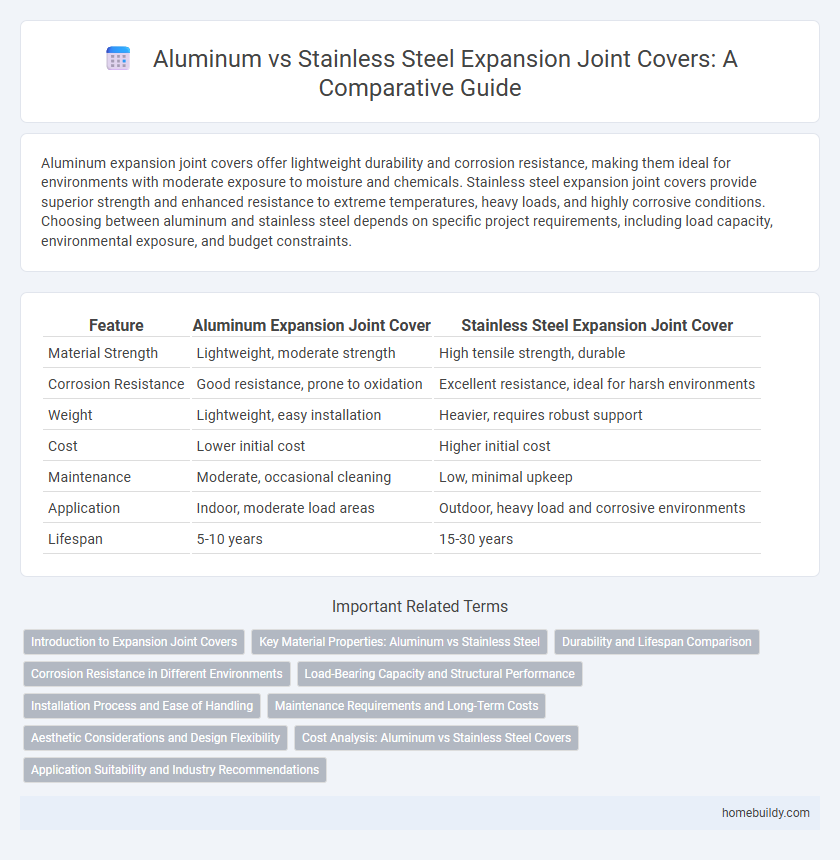Aluminum expansion joint covers offer lightweight durability and corrosion resistance, making them ideal for environments with moderate exposure to moisture and chemicals. Stainless steel expansion joint covers provide superior strength and enhanced resistance to extreme temperatures, heavy loads, and highly corrosive conditions. Choosing between aluminum and stainless steel depends on specific project requirements, including load capacity, environmental exposure, and budget constraints.
Table of Comparison
| Feature | Aluminum Expansion Joint Cover | Stainless Steel Expansion Joint Cover |
|---|---|---|
| Material Strength | Lightweight, moderate strength | High tensile strength, durable |
| Corrosion Resistance | Good resistance, prone to oxidation | Excellent resistance, ideal for harsh environments |
| Weight | Lightweight, easy installation | Heavier, requires robust support |
| Cost | Lower initial cost | Higher initial cost |
| Maintenance | Moderate, occasional cleaning | Low, minimal upkeep |
| Application | Indoor, moderate load areas | Outdoor, heavy load and corrosive environments |
| Lifespan | 5-10 years | 15-30 years |
Introduction to Expansion Joint Covers
Expansion joint covers, essential for accommodating structural movement and preventing damage in buildings, are commonly fabricated from aluminum or stainless steel. Aluminum expansion joint covers offer lightweight, corrosion-resistant properties ideal for indoor applications, while stainless steel covers provide enhanced durability and superior resistance to harsh environments and heavy traffic. Selecting the appropriate material depends on factors such as environmental exposure, load requirements, and maintenance considerations to ensure optimal performance and longevity.
Key Material Properties: Aluminum vs Stainless Steel
Aluminum expansion joint covers offer lightweight strength and excellent corrosion resistance due to their natural oxide layer, making them ideal for environments where weight reduction is critical. Stainless steel expansion joint covers provide superior durability, higher tensile strength, and enhanced resistance to extreme temperatures and chemical exposure, suitable for heavy-duty and industrial applications. The choice between aluminum and stainless steel depends on balancing factors like load capacity, environmental conditions, and maintenance requirements.
Durability and Lifespan Comparison
Aluminum expansion joint covers offer excellent corrosion resistance and lightweight properties, making them suitable for environments with moderate wear and non-extreme exposure. Stainless steel expansion joint covers provide superior durability and a significantly longer lifespan due to their high resistance to corrosion, abrasion, and extreme temperatures, often lasting decades in harsh industrial or marine settings. The choice between aluminum and stainless steel hinges on the specific application's environmental challenges and expected maintenance intervals.
Corrosion Resistance in Different Environments
Aluminum expansion joint covers offer excellent corrosion resistance in mildly corrosive and marine environments due to their natural oxide layer, making them suitable for coastal structures and light industrial applications. Stainless steel expansion joint covers, particularly those made from grades 304 or 316, provide superior corrosion resistance in highly aggressive environments, including chemical plants and offshore platforms, due to their chromium and molybdenum content. The choice between aluminum and stainless steel expansion joint covers depends on the specific environmental exposure, with stainless steel preferred for extreme corrosive conditions and aluminum favored for cost-effective protection in less severe settings.
Load-Bearing Capacity and Structural Performance
Aluminum expansion joint covers offer lightweight properties with moderate load-bearing capacity suitable for pedestrian and light vehicular traffic, while stainless steel expansion joint covers provide superior structural performance and higher load-bearing capacity ideal for heavy traffic and industrial applications. Stainless steel's enhanced durability and resistance to corrosion ensure longer lifespan and reduced maintenance in demanding environments. Selection depends on load requirements and environmental conditions, with stainless steel preferred for high-stress scenarios.
Installation Process and Ease of Handling
Aluminum expansion joint covers offer easier handling due to their lightweight properties, significantly reducing labor effort during installation compared to stainless steel covers. The installation process for aluminum covers is typically faster, as the material's flexibility allows for easier adjustments and fitting in varying structural dimensions. Stainless steel expansion joint covers, while more durable, require specialized tools and additional precautions during installation, making the process more time-consuming and complex.
Maintenance Requirements and Long-Term Costs
Aluminum expansion joint covers require less frequent maintenance due to corrosion resistance but may suffer from surface wear in harsh environments, potentially increasing upkeep over time. Stainless steel expansion joint covers offer superior durability and corrosion resistance, resulting in lower long-term maintenance costs despite higher initial investment. Evaluating environmental exposure and budget constraints helps determine the most cost-effective material for expansion joint cover applications.
Aesthetic Considerations and Design Flexibility
Aluminum expansion joint covers offer a lightweight structure with a sleek, modern appearance that easily accommodates custom shapes and anodized finishes for enhanced aesthetic appeal. Stainless steel expansion joint covers provide a polished, high-end look with superior corrosion resistance, allowing for intricate designs and seamless integration in demanding architectural environments. Both materials deliver design flexibility, but aluminum excels in color customization while stainless steel stands out for durability in visually prestigious applications.
Cost Analysis: Aluminum vs Stainless Steel Covers
Aluminum expansion joint covers typically offer a lower upfront cost compared to stainless steel, making them a cost-effective choice for budget-sensitive projects. Stainless steel covers, although more expensive initially, provide superior durability and corrosion resistance, leading to reduced maintenance and replacement expenses over time. The choice between aluminum and stainless steel hinges on balancing initial investment against long-term lifecycle costs and environmental conditions.
Application Suitability and Industry Recommendations
Aluminum expansion joint covers offer lightweight, corrosion-resistant properties ideal for moderate load applications in commercial buildings and pedestrian walkways. Stainless steel expansion joint covers provide superior strength and durability, making them suitable for heavy-duty industrial environments such as oil refineries, chemical plants, and marine structures. Industry recommendations favor aluminum for budget-conscious projects requiring flexibility, while stainless steel is preferred for high-stress, corrosive, or hygienic conditions demanding enhanced longevity.
Aluminum expansion joint cover vs Stainless steel expansion joint cover Infographic

 homebuildy.com
homebuildy.com